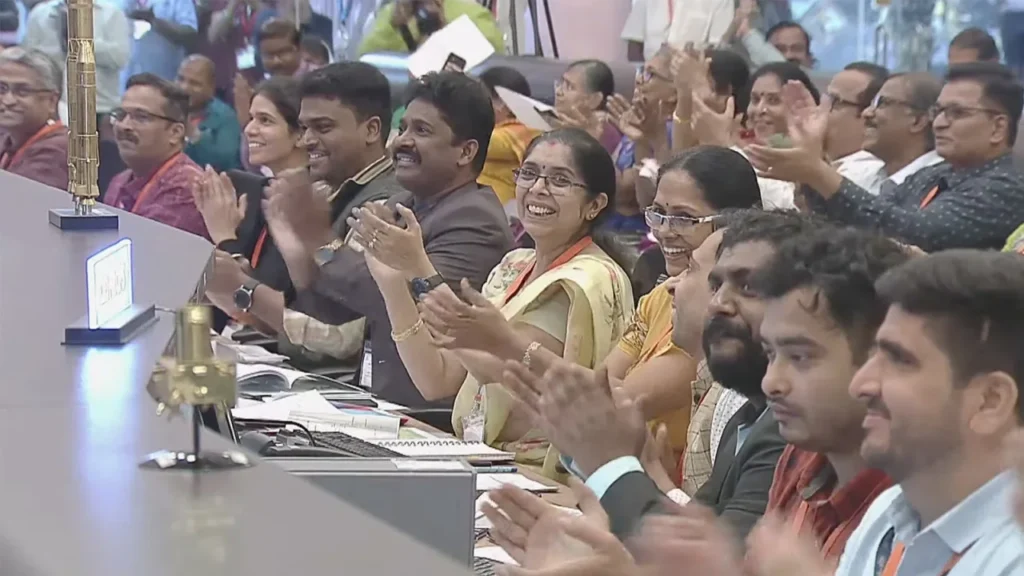India has achieved a monumental milestone in space exploration by successfully landing its Chandrayaan-3 spacecraft on the moon. This accomplishment places India in an exclusive club of nations, becoming only the fourth country in history to achieve a soft landing on the lunar surface. This significant achievement has the potential to solidify India’s position as a global space powerhouse.
In the past, soft landings on the moon were accomplished only by the United States, China, and the former Soviet Union. What sets Chandrayaan-3 apart is its landing site near the moon’s south pole – a region that has not been explored as extensively. This location holds immense scientific and strategic value due to its suspected water ice deposits concealed in shadowy craters. This frozen water could serve as a valuable resource for future space missions, potentially being converted into rocket fuel or even drinking water for crewed missions.
Indian Prime Minister Narendra Modi, who is currently attending the BRICS Summit in South Africa, virtually witnessed the historic landing and shared his thoughts via a livestream. He emphasized that this achievement belongs not just to India but to all of humanity, aligning with India’s overarching approach of unity and cooperation on a global scale.
Historic day for India’s space sector. Congratulations to @isro for the remarkable success of Chandrayaan-3 lunar mission. https://t.co/F1UrgJklfp
— Narendra Modi (@narendramodi) August 23, 2023
The timing of India’s lunar success is particularly noteworthy. Russia’s recent Luna 25 lunar landing attempt ended in failure when the spacecraft crashed into the moon due to engine misfires. This event underscored the complexities and challenges associated with lunar landings.
Chandrayaan-3’s journey involved meticulous maneuvering and precise coordination. Comprising a lander, a rover, and a propulsion module, the spacecraft successfully traversed the vast expanse of 384,400 kilometers (238,855 miles) between Earth and the moon. The lander, named Vikram, executed intricate maneuvers to achieve a gentle touchdown on the lunar surface. Within Vikram rests the rover Pragyan, a six-wheeled exploration vehicle poised to roll onto the moon’s terrain.
The significance of Chandrayaan-3 extends beyond the landing itself. The scientific instruments carried by the 1,700-kilogram (3,748-pound) lander and the 26-kilogram (57.3-pound) rover are expected to provide valuable insights into the moon’s composition and dynamics. Notably, a seismometer on the lander will attempt to detect seismic activity within the moon’s interior, crucial for understanding potential risks for future lunar activities.

India’s success in lunar exploration has garnered immense national pride and widespread interest. Millions tuned in to livestreams to witness the historic event, underscoring the strong connection between the Indian people and their space program. The successful landing was met with celebrations, including the distribution of sweets, lighting of firecrackers, and enthusiastic flag-waving.
As more countries join the global “moon rush,” with plans for lunar missions in the coming years, the challenges of landing on the moon remain substantial. India’s previous attempt, Chandrayaan-2 in 2019, ended in disappointment. Nonetheless, the country’s persistence has yielded remarkable results, making India the second nation in the 21st century to achieve a lunar landing, following China’s efforts.
In the ever-evolving landscape of space exploration, India’s accomplishments are pivotal. Collaborating with established space powers like the United States and France, India’s space program has made remarkable strides in developing cutting-edge technology for space exploration. With Chandrayaan-3, India has demonstrated its commitment to advancing the frontiers of human knowledge and fostering international cooperation in the realm of space.
India’s involvement in the United States’ Artemis Accords, an agreement outlining guidelines for lunar exploration, further exemplifies its commitment to responsible and collaborative space endeavors. This achievement not only represents a leap in scientific progress but also cements India’s role as a leading player in shaping the future of space exploration.
